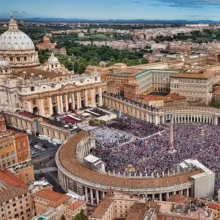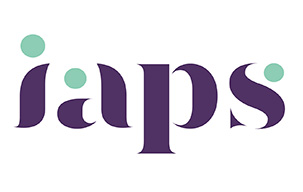This week on Portsmouth Point: The History and the Future of the Vatican

by Hannah H, Year 111
Throughout recent weeks the Vatican has been the subject of many news articles and news programmes. Specifically Pope Francis’s health which has been under careful examination as he spends his second week in hospital being treated for bronchitis and pneumonia. With the future within the Vatican seeming to be unknown, I have decided to educate myself and share that knowledge with others about the Vatican as well as including my own opinion in the face of Pope Fracis’s ill health from which I hope he will recover quickly.
Pope Francis, born Jorge Mario Bergoglio in Buenos Aires, Argentina, is the 266th Pope of the Catholic Church having been elected in 2013. He has had many posts in the catholic church starting in 1958, aged 22, when he decided to become a part of the Jesuit Order after a severe illness. The Jesuit Order is an order of catholic priests who believe in helping others and finding God in all things. From this Pope Francis showed his strong faith to God and quickly gained a prominent role in the Catholic Church in Argentina by being made Archbishop in 1988 and later being appointed a Cardinal in 2001. Two weeks after Pope Benedict XVI ( the 16th) resigned Jorge Mario Bergoglio was elected and chose for his papal name to be Francis after Francis of Assisi, an italian mystic, poet and friar who lived a christian life of poverty during the twelfth and thirteenth century. Currently Pope Francis is known for his humility and his belief in the mercy of God, performing multiple acts like washing prisoners feet, constantly speaking about humanitarian issues and his unwavering belief in God and the mercy that he brings.
The Vatican City, often known for being the world's smallest country, has an extensive history that started in the fourth century when a basilica (a Roman public building) was built over the grave of Saint Peter. Over time the area was developed into a site of pilgrimage but was later abandoned in 1309 when the head of the church was moved to France. When the site of the church was returned to the Vatican in 1377 the now famous sites like the Sistine Chapel and Apostolic Palace were built. The Vatican City was made a sovereign state in 1929. Throughout its turbulent history riddled with war and persecution the Vatican has remained the strong centre of the Catholic Church that has constantly provided leadership and guidance to Catholics around the world.
Throughout its history the Vatican has had a large significance and although in a modern world I believe that religion is not as powerful as it used to be; The Vatican City still remains to be a powerful nation with the Pope being a powerful symbol of catholicism especially in the 21st century. Despite being the smallest county in the world the Vatican receives around five million visitors every year which just proves that the Vatican and religion still has a very important part of many peoples lives. Although the Vatican is not known for being involved in many international and diplomatic discussions the actions of the Pope can affect millions with religion being a powerful motivator for why people believe in the briefs they do. For example many people are against war because of the bible and christianity with many people unfortunately using religion to justify (in my opinion) some potentially very harmful views. I mention this because the current Pope has used his place as the head of the catholic church to educate about humanitarian issues throughout the globe and create change in views amongst those in the catholic church. To me this just highlights the influence of the Vatican City today and how the actions of the Pope (and indeed many other powerful figures) can have on the world. Despite religion not being as prominent as it used to be, the Vatican city and the Pope still have a very large influence over the world and the actions of millions of people.
In recent weeks with the Pope's varying health, I believe that it is important to be informed on what happens in the event of the death of a pope. Most people in this school would have been extremely young when the last Pope died and like me have no previous knowledge of the process of a pope's funeral and the conclave that takes place afterwards. The process begins with the Vatican’s Administrator of properties and revenues (the camerlengo) calling the pope's papal name 3 times and if there is no response he announces “the pope is truly dead”. After a Pope's passing he must be buried within 4-6 days after his death, usually in St Peter's Basilica or in a place of his choosing. Following the funeral there are 9 days of mourning. Then the secretive process of the conclave starts. The conclave is the process of selecting a new pope and takes place around 15-20 days after a pope's death. During this process all eligible cardinals under 80 must lock themselves in the Sistine Chapel where they vote for a pope until he receives a two-thirds majority. After every ballot the votes are burned and the smoke is used to signify to the world if a new pope has been selected. If black smoke billows from the sistine chapel it means a pope has not been selected and if white smokes can be seen it means that a new pope has been chosen. After a new pope has been chosen he must be formally asked if he wishes to accept the role then he chooses his papal name. The senior cardinal then steps out onto the balcony and announces “Habemus Papam” - “We have a new pope” and the newly elected pope steps out and offers his first blessing to the waiting crowd.
With the questions of who the next pope will be it raises the question of who is even eligible for the role and technically any Roman Catholic male can become a pope but since the 14th century every new pope has been selected from a council of cardinals who participate in the conclave. The process of becoming a cardinal takes many years of dedication to the catholic church along with a dedication to academics and theology. This long process of becoming a cardinal takes many years and currently there are only 252 cardinals who have been appointed by the pope and only 138 are eligible to be a part of the conclave and elect a new pope. Whilst there is no certainty on who the 267th Pope will be I am sure that the successor of Pope Francis will fill his position well and accurately represent the catholic religion.
In conclusion, the Vatican has a rich history and an interesting and at times uncertain future. Through the writing of this article I was able to increase my knowledge and yours by sharing the extensive history and traditions of the Vatican and its influence on the world. With Pope Francis’s health being uncertain, millions of people worldwide are praying and thinking of him in recent weeks, as I too wish for the pope's recovery of his health.















.png&command_2=resize&height_2=85)






